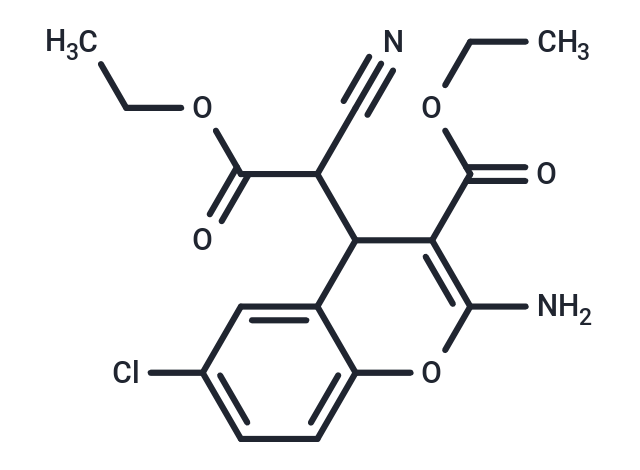Shopping Cart
- Remove All
 Your shopping cart is currently empty
Your shopping cart is currently empty
SC79 is an AKT agonist with specificity and blood-brain barrier permeability. SC79 specifically binds to the PH domain of AKT, activates cytoplasmic AKT, and inhibits AKT membrane translocation. SC79 has neuroprotective activity.

| Pack Size | Price | Availability | Quantity |
|---|---|---|---|
| 2 mg | $34 | In Stock | |
| 5 mg | $52 | In Stock | |
| 10 mg | $86 | In Stock | |
| 25 mg | $135 | In Stock | |
| 50 mg | $197 | In Stock | |
| 100 mg | $328 | In Stock | |
| 200 mg | $528 | In Stock |
| Description | SC79 is an AKT agonist with specificity and blood-brain barrier permeability. SC79 specifically binds to the PH domain of AKT, activates cytoplasmic AKT, and inhibits AKT membrane translocation. SC79 has neuroprotective activity. |
| Targets&IC50 | Akt:4 µg/mL |
| In vitro | METHODS: Human cervical cancer cells were starved of HeLa serum for 1 h, treated with SC79 (4 µg/mL) for 30 min, and the expression levels of target proteins were detected by Western Blot. RESULTS: SC79 enhanced AKT phosphorylation, and SC79-induced AKT phosphorylation mainly occurred in the cytoplasm. [1] METHODS: Human lung cancer cells A549 were treated with SC79 (10 µg/mL) for 24 h. The gene expression level was detected by qPCR. RESULTS: SC79 treatment up-regulated the expression of Nrf-2 (NFE2L2) gene itself as well as the downstream targets HO-1 and NQO-1. [2] |
| In vivo | METHODS: To detect in vivo activity, SC79 (0.04 mg/g) was injected intraperitoneally into a C57 Black/6 mouse model of copper relaxation demyelination, and 5 min later middle cerebral artery occlusion (MCAO) was performed to construct an ischemic stroke model. RESULTS: A single dose of SC79 reduced the size of neocortical lesions by more than 35% and 40% at 24 h after MCAO and 1 week after MCAO, respectively. [1] METHODS: To investigate the effect on liver injury, SC79 (10 mg/kg) was injected intraperitoneally into C57BL/6 mice, and d-Gal/LPS was injected 0.5 h later to induce liver injury. RESULTS: SC79 protected mice from TNF-α-mediated liver injury induced by d-Gal/LPS. [3] |
| Kinase Assay | Cytosolic phosphorylation of Akt: Hela cells are serum starved for 1 hr and treated with IGF (100ng/mL) or SC79 (4 μg/mL) for 30 minutes. Cells are lysed in Lysis buffer containing 250 mM Sucrose, 20 mM HEPES, 10 mM KCl, 1.5 mM MgCl2, 1 mM EDTA, 1 mM EGTA supplemented with protease inhibitors. Cells are passed through 25 g needle several times and kept on ice for 20 minutes. Total cell lysate is taken at this point. Cell lysates are centrifuged at 100,000 g for 30 minutes. Supernatant is collected as the cytosolic fraction. Pellet is washed with lysis buffer and represents the membrane fraction. Total cell lysate, cytosolic and membrane fractions are resolved by SDS-PAGE and analyzed for phospho-Akt (S473), Total Akt, Tubulin (cytosolic marker) and Orai1 (membrane marker) by western blotting. |
| Cell Research | HsSultan or NB4 cells (2.5 × 105) are plated in a 24-well plate in 500 μL of phenol red-free RPMI medium supplemented with 10% FBS. After incubation for 24 hours, each compound (8 μg/mL) is added and cultured for overnight (16–20 h). Fifty microliters of MTT solution (5 mg/mL in PBS) are added to each well. Following 2 hrs incubation, the purple formazan crystals are dissolved by directly adding in 500 μL of isopropanol with 0.1 M HCl to each well. After clearing the cell debris by centrifugation, the absorbance is measured at a wavelength of 570 nm.(Only for Reference) |
| Synonyms | SC 79 |
| Molecular Weight | 364.78 |
| Formula | C17H17ClN2O5 |
| Cas No. | 305834-79-1 |
| Smiles | CCOC(=O)C(C#N)C1C(C(=O)OCC)=C(N)Oc2ccc(Cl)cc12 |
| Relative Density. | 1.340 g/cm3 (Predicted) |
| Storage | store at low temperature,keep away from moisture | Powder: -20°C for 3 years | In solvent: -80°C for 1 year | Shipping with blue ice/Shipping at ambient temperature. | |||||||||||||||||||||||||||||||||||
| Solubility Information | DMSO: 55 mg/mL (150.78 mM), Sonication is recommended. | |||||||||||||||||||||||||||||||||||
| In Vivo Formulation | 10% DMSO+40% PEG300+5% Tween 80+45% Saline: 5.5 mg/mL (15.08 mM), Solution. Please add the solvents sequentially, clarifying the solution as much as possible before adding the next one. Dissolve by heating and/or sonication if necessary. Working solution is recommended to be prepared and used immediately. The formulation provided above is for reference purposes only. In vivo formulations may vary and should be modified based on specific experimental conditions. | |||||||||||||||||||||||||||||||||||
Solution Preparation Table | ||||||||||||||||||||||||||||||||||||
DMSO
| ||||||||||||||||||||||||||||||||||||

Copyright © 2015-2025 TargetMol Chemicals Inc. All Rights Reserved.